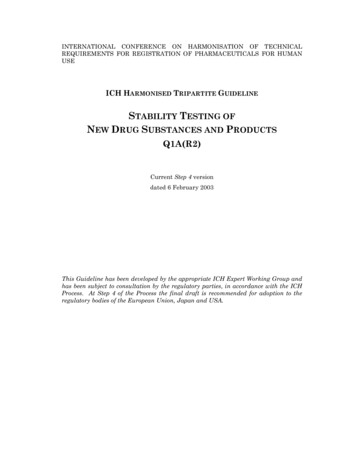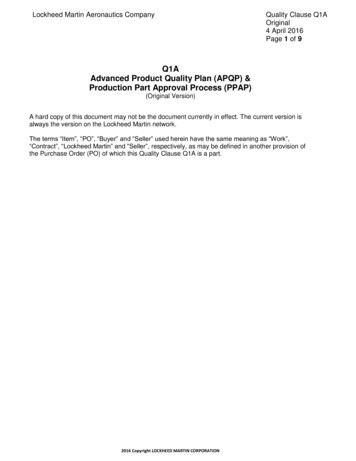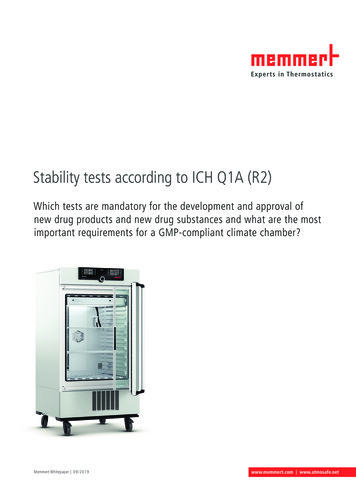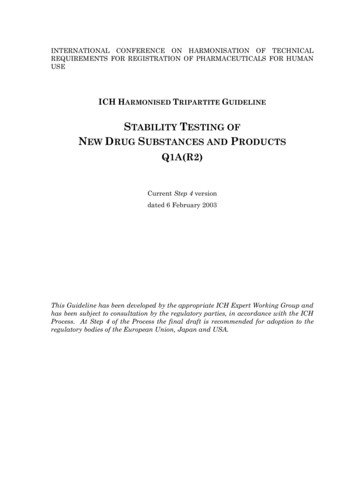
Transcription
INTERNATIONAL CONFERENCE ON HARMONISATION OF TECHNICALREQUIREMENTS FOR REGISTRATION OF PHARMACEUTICALS FOR HUMANUSEICH HARMONISED TRIPARTITE GUIDELINESTABILITY TESTING OFNEW DRUG SUBSTANCES AND PRODUCTSQ1A(R2)Current Step 4 versiondated 6 February 2003This Guideline has been developed by the appropriate ICH Expert Working Group andhas been subject to consultation by the regulatory parties, in accordance with the ICHProcess. At Step 4 of the Process the final draft is recommended for adoption to theregulatory bodies of the European Union, Japan and USA.
Q1A(R2)Document November2005Q1Approval by the Steering Committee under Step 2and release for public consultation.16September1992Q1Q1AApproval by the Steering Committee under Step 4and recommendation for adoption to the threeICH regulatory bodies.27 October1993Q1AQ1 was renamed Q1A.Q1A(R)Approval by the Steering Committee of the firstrevision under Step 2 and release for publicconsultation.7 October1999Q1A(R1)Q1A(R)Approval by the Steering Committee of the firstrevision under Step 4 and recommendation foradoption to the three ICH regulatory bodies.8November2000Q1A(R1)6 February2003Q1A(R2)Current Step 4 versionQ1A(R2)Approval by the Steering Committee of the secondrevision directly under Step 4 without furtherpublic consultation, to include consequences of theadoption of Q1F (Stability Data Package forRegistration Applications in Climatic Zones III andIV), and recommendation for adoption to the threeICH regulatory bodies.
COVER NOTE FOR REVISION OF Q1A(R)STABILITY TESTING OFNEW DRUG SUBSTANCES AND PRODUCTSThe purpose of this note is to outline the changes made in Q1A(R) that result fromadoption of ICH Q1F “Stability Data Package for Registration Applications inClimatic Zones III and IV”. These changes are:1. The intermediate storage condition has been changed from 30 C 2 C/60%RH 5% RH to 30 C 2 C/65% RH 5% RH in the following sections: 2.1.7.1 Drug Substance - Storage Conditions - General Case 2.2.7.1 Drug Product - Storage Conditions - General Case 2.2.7.3 Drug products packaged in semi-permeable containers 3Glossary - “Intermediate testing”2. 30 C 2 C/65% RH 5% RH can be a suitable alternative long-term storagecondition to 25 C 2 C/60% RH 5% in the following sections: 2.1.7.1 Drug Substance - Storage Conditions - General Case 2.2.7.1 Drug Product - Storage Conditions - General Case3. 30 C 2 C/35% RH 5% RH has been added as a suitable alternative longterm storage condition to 25 C 2 C/40% RH 5% and the correspondingexample for the ratio of water-loss rates has been included in the followingsection: 2.2.7.3 Drug products packaged in semi-permeable containersMid-stream switch of the intermediate storage condition from 30 C 2 C/60% RH 5% RH to 30 C 2 C/65% RH 5% RH can be appropriate provided that therespective storage conditions and the date of the switch are clearly documented andstated in the registration application.It is recommended that registration applications contain data from complete studiesat the intermediate storage condition 30 C 2 C/65% RH 5% RH, if applicable, bythree years after the date of publication of this revised guideline in the respective ICHtripartite region.
STABILITY TESTING OFNEW DRUG SUBSTANCES AND PRODUCTSICH Harmonised Tripartite GuidelineFirst Recommended for Adoption at Step 4 of the ICH Process on 27 October 1993.Revised under Step 2 of the ICH Process on 7 October 1999 and Recommended forAdoption at Step 4 of the ICH Process on 8 November 2000.This guideline has been Revised a second time and has reached Step 4 of the ICHProcess at the ICH Steering Committee meeting on 6 February 2003. It isrecommended for adoption to the three regulatory parties to ICHTABLE OF CONTENTS1. INTRODUCTION . 11.1. Objectives of the Guideline . 11.2. Scope of the Guideline. 11.3. General Principles . 12.GUIDELINES. 12.1. Drug Substance. 12.1.1. General. 12.1.2. Stress Testing . 12.1.3. Selection of Batches . 22.1.4. Container Closure System . 22.1.5. Specification . 22.1.6. Testing Frequency . 32.1.7. Storage Conditions . 32.1.8. Stability Commitment . 52.1.9. Evaluation . 52.1.10. Statements/Labeling . 6i
Stability Testing of New Drug Substances and Products2.2. Drug Product2.2.1. General. 6. 62.2.2. Photostability Testing . 62.2.3. Selection of Batches . 62.2.4. Container Closure System . 72.2.5. Specification. 72.2.6. Testing Frequency . 72.2.7. Storage Conditions . 82.2.8. Stability Commitment. 122.2.9. Evaluation . 122.2.10. Statements/Labeling . 133.GLOSSARY. 134.REFERENCES . 17ii
STABILITY TESTING OF NEW DRUG SUBSTANCES AND PRODUCTS1.INTRODUCTION1.1.Objectives of the GuidelineThe following guideline is a revised version of the ICH Q1A guideline and defines thestability data package for a new drug substance or drug product that is sufficient for aregistration application within the three regions of the EC, Japan, and the UnitedStates. It does not seek necessarily to cover the testing for registration in or export toother areas of the world.The guideline seeks to exemplify the core stability data package for new drugsubstances and products, but leaves sufficient flexibility to encompass the variety ofdifferent practical situations that may be encountered due to specific scientificconsiderations and characteristics of the materials being evaluated. Alternativeapproaches can be used when there are scientifically justifiable reasons.1.2.Scope of the GuidelineThe guideline addresses the information to be submitted in registration applicationsfor new molecular entities and associated drug products. This guideline does notcurrently seek to cover the information to be submitted for abbreviated or abridgedapplications, variations, clinical trial applications, etc.Specific details of the sampling and testing for particular dosage forms in theirproposed container closures are not covered in this guideline.Further guidance on new dosage forms and on biotechnological/biological products canbe found in ICH guidelines Q1C and Q5C, respectively.1.3.General PrinciplesThe purpose of stability testing is to provide evidence on how the quality of a drugsubstance or drug product varies with time under the influence of a variety ofenvironmental factors such as temperature, humidity, and light, and to establish a retest period for the drug substance or a shelf life for the drug product andrecommended storage conditions.The choice of test conditions defined in this guideline is based on an analysis of theeffects of climatic conditions in the three regions of the EC, Japan and the UnitedStates. The mean kinetic temperature in any part of the world can be derived fromclimatic data, and the world can be divided into four climatic zones, I-IV. Thisguideline addresses climatic zones I and II. The principle has been established thatstability information generated in any one of the three regions of the EC, Japan andthe United States would be mutually acceptable to the other two regions, provided theinformation is consistent with this guideline and the labeling is in accord withnational/regional requirements.2.GUIDELINES2.1.Drug Substance2.1.1. GeneralInformation on the stability of the drug substance is an integral part of the systematicapproach to stability evaluation.2.1.2.Stress Testing1
Stability Testing of New Drug Substances and ProductsStress testing of the drug substance can help identify the likely degradation products,which can in turn help establish the degradation pathways and the intrinsic stabilityof the molecule and validate the stability indicating power of the analyticalprocedures used. The nature of the stress testing will depend on the individual drugsubstance and the type of drug product involved.Stress testing is likely to be carried out on a single batch of the drug substance. Itshould include the effect of temperatures (in 10 C increments (e.g., 50 C, 60 C, etc.)above that for accelerated testing), humidity (e.g., 75% RH or greater) whereappropriate, oxidation, and photolysis on the drug substance. The testing should alsoevaluate the susceptibility of the drug substance to hydrolysis across a wide range ofpH values when in solution or suspension. Photostability testing should be anintegral part of stress testing. The standard conditions for photostability testing aredescribed in ICH Q1B.Examining degradation products under stress conditions is useful in establishingdegradation pathways and developing and validating suitable analytical procedures.However, it may not be necessary to examine specifically for certain degradationproducts if it has been demonstrated that they are not formed under accelerated orlong term storage conditions.Results from these studies will form an integral part of the information provided toregulatory authorities.2.1.3. Selection of BatchesData from formal stability studies should be provided on at least three primarybatches of the drug substance. The batches should be manufactured to a minimum ofpilot scale by the same synthetic route as, and using a method of manufacture andprocedure that simulates the final process to be used for, production batches. Theoverall quality of the batches of drug substance placed on formal stability studiesshould be representative of the quality of the material to be made on a productionscale.Other supporting data can be provided.2.1.4. Container Closure SystemThe stability studies should be conducted on the drug substance packaged in acontainer closure system that is the same as or simulates the packaging proposed forstorage and distribution.2.1.5. SpecificationSpecification, which is a list of tests, reference to analytical procedures, and proposedacceptance criteria, is addressed in ICH Q6A and Q6B. In addition, specification fordegradation products in a drug substance is discussed in Q3A.Stability studies should include testing of those attributes of the drug substance thatare susceptible to change during storage and are likely to influence quality, safety,and/or efficacy. The testing should cover, as appropriate, the physical, chemical,biological, and microbiological attributes. Validated stability-indicating analyticalprocedures should be applied. Whether and to what extent replication should beperformed will depend on the results from validation studies.2
Stability Testing of New Drug Substances and Products2.1.6. Testing FrequencyFor long term studies, frequency of testing should be sufficient to establish thestability profile of the drug substance. For drug substances with a proposed re-testperiod of at least 12 months, the frequency of testing at the long term storagecondition should normally be every 3 months over the first year, every 6 months overthe second year, and annually thereafter through the proposed re-test period.At the accelerated storage condition, a minimum of three time points, including theinitial and final time points (e.g., 0, 3, and 6 months), from a 6-month study isrecommended. Where an expectation (based on development experience) exists thatresults from accelerated studies are likely to approach significant change criteria,increased testing should be conducted either by adding samples at the final time pointor by including a fourth time point in the study design.When testing at the intermediate storage condition is called for as a result ofsignificant change at the accelerated storage condition, a minimum of four timepoints, including the initial and final time points (e.g., 0, 6, 9, 12 months), from a 12month study is recommended.2.1.7. Storage ConditionsIn general, a drug substance should be evaluated under storage conditions (withappropriate tolerances) that test its thermal stability and, if applicable, its sensitivityto moisture. The storage conditions and the lengths of studies chosen should besufficient to cover storage, shipment, and subsequent use.The long term testing should cover a minimum of 12 months’ duration on at leastthree primary batches at the time of submission and should be continued for a periodof time sufficient to cover the proposed re-test period. Additional data accumulatedduring the assessment period of the registration application should be submitted tothe authorities if requested. Data from the accelerated storage condition and, ifappropriate, from the intermediate storage condition can be used to evaluate theeffect of short term excursions outside the label storage conditions (such as mightoccur during shipping).Long term, accelerated, and, where appropriate, intermediate storage conditions fordrug substances are detailed in the sections below. The general case applies if thedrug substance is not specifically covered by a subsequent section. Alternativestorage conditions can be used if justified.2.1.7.1. General caseStudyStorage conditionMinimum time period covered bydata at submissionLong term*25 C 2 C/60% RH 5% RH 12 monthsor30 C 2 C/65% RH 5% RHIntermediate**30 C 2 C/65% RH 5% RH6 monthsAccelerated40 C 2 C/75% RH 5% RH6 months*It is up to the applicant to decide whether long term stability studies are performedat 25 2 C/60% RH 5% RH or 30 C 2 C/65% RH 5% RH.3
Stability Testing of New Drug Substances and Products**If 30 C 2 C/65% RH 5% RH is the long-term condition, there is no intermediatecondition.If long-term studies are conducted at 25 C 2 C/60% RH 5% RH and “significantchange” occurs at any time during 6 months’ testing at the accelerated storagecondition, additional testing at the intermediate storage condition should beconducted and evaluated against significant change criteria. Testing at theintermediate storage condition should include all tests, unless otherwise justified. Theinitial application should include a minimum of 6 months’ data from a 12-monthstudy at the intermediate storage condition.“Significant change” for a drug substance is defined as failure to meet its specification.2.1.7.2. Drug substances intended for storage in a refrigeratorStudyStorage conditionMinimum time period covered bydata at submissionLong term5 C 3 C12 monthsAccelerated25 C 2 C/60% RH 5% RH6 monthsData from refrigerated storage should be assessed according to the evaluation sectionof this guideline, except where explicitly noted below.If significant change occurs between 3 and 6 months’ testing at the acceleratedstorage condition, the proposed re-test period should be based on the real time dataavailable at the long term storage condition.If significant change occurs within the first 3 months’ testing at the acceleratedstorage condition, a discussion should be provided to address the effect of short termexcursions outside the label storage condition, e.g., during shipping or handling. Thisdiscussion can be supported, if appropriate, by further testing on a single batch of thedrug substance for a period shorter than 3 months but with more frequent testingthan usual. It is considered unnecessary to continue to test a drug substance through6 months when a significant change has occurred within the first 3 months.2.1.7.3. Drug substances intended for storage in a freezerStudyStorage conditionMinimum time period covered bydata at submissionLong term- 20 C 5 C12 monthsFor drug substances intended for storage in a freezer, the re-test period should bebased on the real time data obtained at the long term storage condition. In theabsence of an accelerated storage condition for drug substances intended to be storedin a freezer, testing on a single batch at an elevated temperature (e.g., 5 C 3 C or25 C 2 C) for an appropriate time period should be conducted to address the effect ofshort term excursions outside the proposed label storage condition, e.g., duringshipping or handling.2.1.7.4. Drug substances intended for storage below -20 C4
Stability Testing of New Drug Substances and ProductsDrug substances intended for storage below -20 C should be treated on a case-by-casebasis.2.1.8. Stability CommitmentWhen available long term stability data on primary batches do not cover the proposedre-test period granted at the time of approval, a commitment should be made tocontinue the stability studies post approval in order to firmly establish the re-testperiod.Where the submission includes long term stability data on three production batchescovering the proposed re-test period, a post approval commitment is consideredunnecessary. Otherwise, one of the following commitments should be made:1.If the submission includes data from stability studies on at least three productionbatches, a commitment should be made to continue these studies through theproposed re-test period.2.If the submission includes data from stability studies on fewer than threeproduction batches, a commitment should be made to continue these studiesthrough the proposed re-test period and to place additional production batches, toa total of at least three, on long term stability studies through the proposed retest period.3.If the submission does not include stability data on production batches, acommitment should be made to place the first three production batches on longterm stability studies through the proposed re-test period.The stability protocol used for long term studies for the stabilit
ICH HARMONISED TRIPARTITE GUIDELINE STABILITY TESTING OF NEW DRUG SUBSTANCES AND PRODUCTS Q1A(R2) Current Step 4 version dated 6 February 2003 This Guideline has been developed by the appropriate ICH Expert Working Group and has been subject to consultation by the regulatory part











